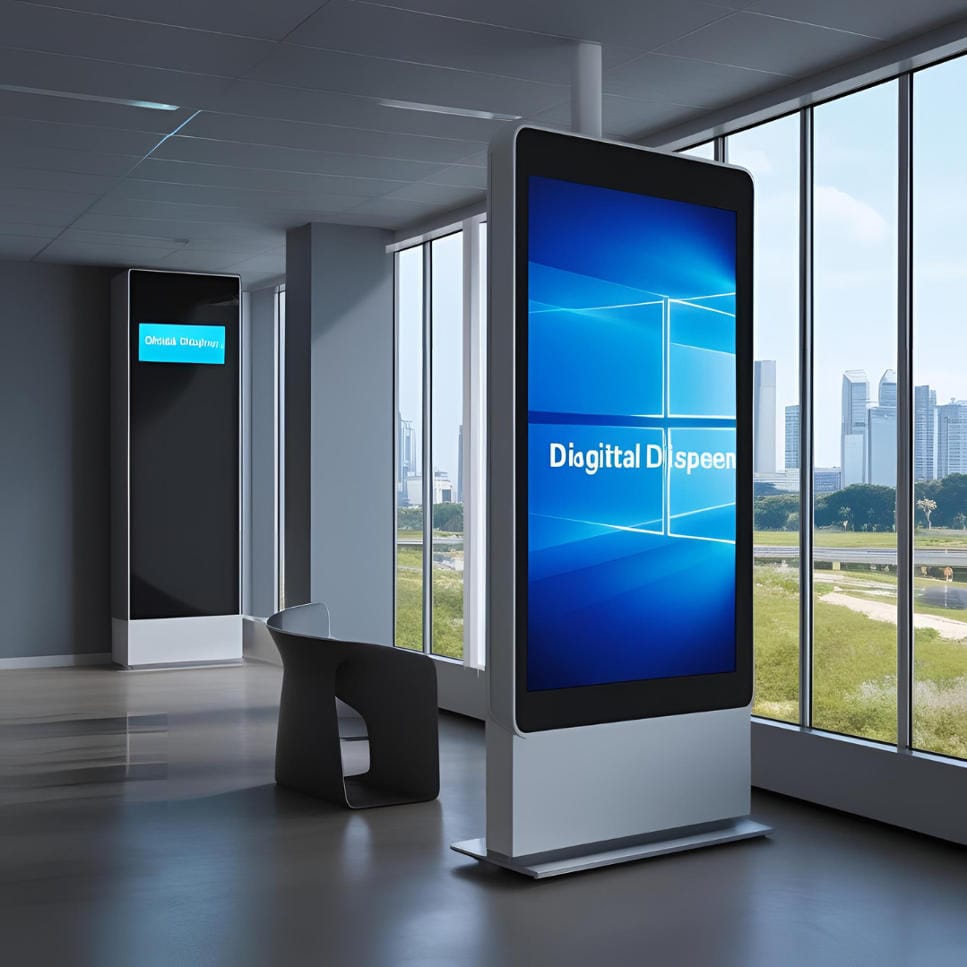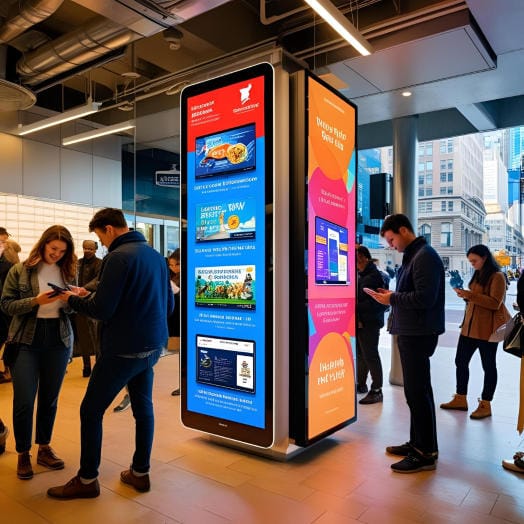What Is a Digital Standee in Digital Signage?
A digital signage standee is a type of display that standees alone and displays images, videos, promotions, and other information. It uses digital signs and displays, instead of banners and cardboard, to draw more attention from customers. You can find these units in shops, malls, airports, restaurants, exhibitions, and places in the hospitality industry. A digital signage standee is more portable and has everything it needs inside, unlike wall-mounted displays. Most of these units have a digital screen mounted on an LED or digital signage standee, with the whole unit built into a sleek case that may have wheels or a fixed base.
 Why Your Business Needs a Digital Signage Standee
Why Your Business Needs a Digital Signage Standee
Attracts Foot Traffic
With their bright colors and noticeable design, standee are great for catching attention in the entrance or walkways. Having a standee at the entrance can attract customers and make them want to enter.
Enhances Brand Image
Using a digital signage standee can give your business a modern and classy image. Having your brand’s colors and logo in your visuals or messages makes your brand more noticeable and supports your identity.
Easy Content Updates
Update promotions or announcements from anywhere using a content management system, instead of having to print new signs or banners. Because of this, businesses can easily update their content as needed.
Cost-Efficient
With time, using digital signage is more cost-effective than printing out new signs or banners. Thanks to the long-term savings, it is an appealing choice for firms that need to limit their marketing expenses.
Interactive Options
Some digital signage standees come with touch screens for wayfinding or to look through products. With these interactive elements, users are more involved and enjoy the experience more.
Types of Digital Signage Standee
Digital Signage LED Standee
They rely on LED screens to make sure the boards are bright and visible in all kinds of light. The LED standee is perfect for use in shopping malls, airports, and any outdoor areas, as they are eye-catching and bright.
LCD Digital Signage Standee
Indoors, it’s much more likely to find LCD screens. They are a good option for indoor use as they produce high-quality video and images at a price that is often less than LEDs.
Touch Screen Standee
Because they have touch screens, these standees are suitable for use in wayfinding, self-check-in, and product browsing in retail areas. They help users access information in an easy way.
Dual-Sided Standee
Since the standee has information on both sides, they are perfect for putting in places where people can see them from any direction.
Custom-Built Digital Signage Standees
Companies that require something particular can get custom-made signage standees with chosen casings, colors, branding, and shapes. They are made to form a unified brand identity and can be used in various workplaces.
 Key Features to Look For
Key Features to Look For
Screen Resolution
Pick an image resolution of at least Full HD to get the best clarity. If your content needs to be seen as the best quality, choose 4K resolution for high-end or detailed visuals.
Brightness Level
In places with a lot of light, such as outdoors, you should go for displays that are very bright (≥ 1000 nits). An LED standee for digital signage is great in bright places, making your message visible to many.
Touchscreen Capabilities
Being able to interact with a device using touch is very important. Customers enjoy using capacitive touchscreens more because they are faster and smoother than resistive ones.
Connectivity Options
It is important that the standee has USB, HDMI, Wi-Fi, and 4G connectivity for remote updates. You can easily update and manage your content on different platforms thanks to the many connectivity options.
Built-In Media Player
A media player that is built-in requires less additional hardware and makes maintenance easier. It helps businesses quickly and easily set up their systems.
Understanding Digital Signage Standee Price
| Feature | Cost Impact |
| Screen Size (32”-75”+) | Larger screens = higher cost |
| Display Type (LCD vs. LED) | LED is more expensive |
| Touchscreen Functionality | Adds significant cost |
| Brightness Levels | High brightness increases the price |
| Connectivity & Media Players | Integrated features cost more |
| Custom Branding | Custom casings add expense |
| Software License | One-time or subscription fees |
Estimated Price Ranges
- Basic LCD Standee: $400–$900
- Touchscreen Standee: $800–$2,000
- Digital Signage LED Standee: $1,200–$5,000+
- Custom Designed Standee: Varies widely, $2,000+
Where to Use a Digital Signage LED Standee
Retail Stores
You can set up digital signage standees by store entrances to advertise new arrivals, discounts, or bestsellers. Moving slideshows are more eye-catching than just having static signs, which can attract more customers.
Hotels and Hospitality
You can use digital signage to welcome guests at hotels and resorts, show conference agendas, or give directions to guests. The standee can be placed anywhere you want.
Restaurants and Cafes
Digital standee makes it easy for restaurants and cafes to change their menus and share promotions each day. You can update your products in real-time through CMS for better engagement with customers.
Airports and Transportation Hubs
Airports may put up digital signage standee for flight updates, directions, or promotional ads. They are great for use in areas where a lot of people are moving quickly.
Events and Trade Shows
Digital signage standees work well for use at events and trade shows. They are convenient for displaying products or information about events in busy places.
Picking the Best Digital Signage Display Standee
What’s the Primary Purpose?
You should first decide if your standee is for showing information, advertising, or interacting with people. If you need information, choose a bright, simple screen, and for promotion, a high-res LED or 4K screen will do.
Indoor or Outdoor Use?
Standee placed outdoors should be able to handle different weather and be made of strong and bright materials. When working indoors, designers can concentrate on making the details and quality of their designs better.
Do You Need Portability?
If you want something that is easy to move around, select models that are light or come with wheels. This gives the ability to easily move and reposition the standee as needed.
What’s the Content Strategy?
Consider how often you will be updating the content. When updates are frequent, go for a standee that has a great CMS and simple update functions.
Branding Needs?
If you need branding, go for custom-branded casings. You may find manufacturers who allow you to create a design that matches your company.
Software Compatibility and CMS Options
It is the content on the digital signage standee that makes a difference. This is why it is necessary to integrate software. You should watch for these main features when choosing a CMS:
Cloud-Based Management
It is very important to be able to edit content remotely from any place. Flexibility and easy use are two benefits that cloud-based systems offer businesses with several standee points or locations.
Multi-Screen Syncing
It is crucial for businesses to synchronize their digital signage displays when they have several displays. With a CMS that supports multi-screen syncing, all devices are kept consistent.
Scheduling Tools
Scheduling tools give companies the ability to organize their content and timing. It is important to make content suitable for different times of the day, events, or promotions.
Templates
A lot of CMS platforms feature drag-and-drop templates to help with design. This feature allows businesses to make content without needing design skills.
Analytics
You can use analytics with your digital signage to monitor how much the content is being viewed or how long the screens are turned on. You can use this data to make your content and user experience better.
 Digital Signage Standee Maintenance Tips
Digital Signage Standee Maintenance Tips
Cleaning and Care
To ensure digital signage units work well, they should be regularly cleaned. It’s best to clean the screen with mild, harmless cleaners and not use rough clothes or paper towels.
Software Updates
Keep the CMS up-to-date and always download any updates released by the manufacturer. With this, the system continues to function efficiently and adds the newest features.
Content Management
Change the visuals every week to stop them from burning into the screen. Keep an eye on the performance of the standee to make sure it works without lag.
Hardware Inspections
Inspect the standee each time to check for loose cables, any damage to ports, or other wear and tear. Be sure that the standee is stable and does not fall over.
Frequently Asked Questions
What is the average digital signage standee price?
Standard LED touchscreen standees cost between $400 and $5,000 for more elaborate or custom-designed ones.
Is a digital signage LED standee better than LCD?
Because LED standee is bright, they are great for places that get a lot of foot traffic or are well-lit. However, they are usually more expensive.
Can I use my own software on a digital signage standee?
It depends on the type of operating system the standee is using. Many third-party apps can be used on Android models, but some might require a special CMS from the manufacturer.
How do I update content on my digital signage standee?
The latest standee usually includes cloud-based CMS platforms, so you can remotely update them from any web dashboard or mobile application.
What screen sizes are available?
The average screen size varies from 32 inches to 75 inches. It is easier to see things on larger screens from farther away.
Can a digital signage display standee be used outdoors?
Yet, it has to be labeled for outside use and should have strong enclosures and very high brightness (2000+ nits) to fight against sunlight.
Are there digital signage stands with wheels for mobility?
Yes. A lot of standees are designed with wheels that can lock, making them easy to transport and place.
What types of businesses benefit most from digital signage standees?
The main industries that benefit from these devices are retail, hospitality, healthcare, restaurants, education, and event management.


 Why Your Business Needs a Digital Signage Standee
Why Your Business Needs a Digital Signage Standee Key Features to Look For
Key Features to Look For Digital Signage Standee Maintenance Tips
Digital Signage Standee Maintenance Tips


